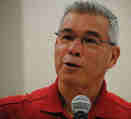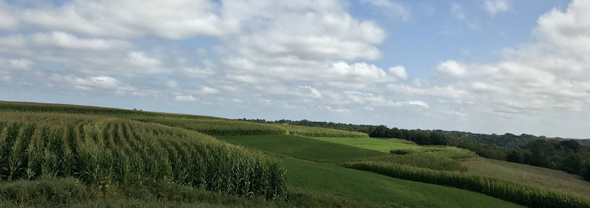|
University of Minnesota Extension and the Minnesota Agricultural Water Resource Center invite you to the 2019 Nutrient Management Conference. It will be Tuesday, Feb. 19, 8:15 a.m. to 3:40 p.m. at the Best Western Kelly Inn, St. Cloud. Sessions will cover challenges in phosphorus and sulfur management, nitrogen applications under irrigation, effects of phosphorus availability due to residue management, Haney Soil Health Test, and managing micronutrients for soybeans. Certified crop advisers will be able to earn continuing education credits in soil and water and nutrient management. The $20 registration fee is payable at the door, or register online.

Friday, March 1, 1:30 p.m., Livestock and Poultry Environmental Learning Center Registration and more information. This webinar will take a look at current practical research in South Dakota and Michigan related to manure use as it relates to soil health. It will focus on principles and practices that enhance soil organic matter formation, including quality of manure and using other organic matter sources in combination to improve soil health.
Manure provides tremendous benefits to the soil health when compared to synthetic fertilizer. Soil organic carbon, water infiltration and pH are increased while bulk density is decreased. Manure applications according to crop nutrient requirements and the use of soil testing are very important tools used for environmental protection. CCA credits applied for. To learn more about events hosted by the Livestock and Poultry Environmental Learning Community, subscribe or unsubscribe to the lpenews list at any time at http://water.unl.edu/lpe-subscribe.
|

A cover crops and reduced tillage information meeting will be 8:30 a.m.-12:30 p.m. Tuesday, Feb. 12 at the Renville Community Center. Featured speaker will be Dr. Jerry Hatfield (photo) of the USDA-ARS on ag practices and weather, nitrogen and cover crops. A farmer panel will discuss their experiences with cover crops and reduced tillage. Lunch will be provided with an RSVP by Feb. 6 to 320-523-3666, or email to: Heidi@hawkcreekwatershed.org. The event is sponsored by the Hawk Creek Watershed Project and Renville SWCD. Information will be available from cover crop suppliers, consultants, applicators, and equipment suppliers.
|
An update on current University of Minnesota agricultural research will be presented Feb. 12-14 at University of Minnesota Research and Outreach Centers. Feb. 12: West Central ROC, Morris; Feb. 13: Southwest ROC, Lamberton; Feb. 14: Southern ROC, Waseca. Presentations and speakers include:
•Farm Income Trends: The Good, The Bad, and The Reality, Nathan Hulinsky, Extension Educator, Applied Economics.
•“Kernza” Intermediate wheatgrass for grazing and as a dual purpose cover crop, Bradley Heins, Associate Professor, WCROC.
•Utilization of cover crops (winter camelina) by pigs, Yuzhi Li, Associate Professor, WCROC.
•Corn and Soybean Weed Management, Thomas Hoverstad, Researcher, SROC.
•Expecting the unexpected in insect and disease management. How to hedge your bets, Bruce Potter, Integrated Pest Management Specialist, SWROC.
•A watershed approach to treating agricultural drainage and surface runoff, Jeff Strock, Professor, SWROC
•Phosphorus Application to MN Soils, Paulo Pagliari, Assistant Professor, SWROC.
•Benefits and Limitations of Cover Crops Use in Minnesota, Axel Garcia y .Garcia, Assistant Professor, SWROC.
The event will be 9:30 a.m.-3:15 p.m. and is open to the public. Registration will begin at 9 a.m. and costs $40 (includes lunch). Walk-ins are welcome but pre-registration is encouraged. Continuing education units for certified crop advisers have been applied for. Register by mail. Register online. For more information contact Emily Evans at 507-752-7372 or eneperma@umn.edu .
Feedlots with NPDES or SDS operating permits are required send their annual reports to the MPCA by March 1, 2019. New this year, the completed form must be submitted as a PDF via e-mail to FeedlotSubmittal.pca@state.mn.us. The form is available on the MPCA feedlot program NPDES-SDS permit webpage. Submittal instructions are included on page four of the form. If you have questions or need assistance, contact your regional MPCA office. A map of regional offices along with addresses is found on page 4 of the report form.
All land application records for the 12-month period starting Sept. 1, 2017, through Aug. 31, 2018, must be submitted as part of the report and on the included forms. For farms that do not transfer manure, land application records can also be generated and submitted using the MPCA Excel-based Manure Management Planner under Create Crop Year Records. A link to the planner is located on the feedlot program Nutrient and Manure Management webpage. Annual reports provide valuable information for determining compliance with Minnesota’s feedlot rules. Failure to submit annual reports by the March 1 deadline may result in an enforcement action from the MPCA.
NRCS will be accepting applications for grants and agreements for leveraging NRCS resources, addressing local natural resource issues, encouraging collaboration and developing state- and community-level conservation leadership. In Minnesota about $4.5 million could be available for grants ranging from $100,000 to $2 million.
Proposals are due Feb. 20 by email to MN.NRCS.CCGA@nrcs.usda.gov. Grants.gov requires use of the Workspace feature to fill out Standard Forms. Download individual PDF forms in Workspace and save. For more information contact Jennifer Sweeney, Assistant State Conservationist for Management and Strategy, (651) 602-7930, jennifer.sweeney@mn.usda.gov.
The purpose of Conservation Collaboration Grants or Agreements is to leverage NRCS and partner resources to: 1) Improve soil health, 2) Improve water quality, 3) Provide habitat for local wildlife species of concern, 4) Improve the environmental and economic performance of working agricultural lands, 5) Assist communities and groups to build and strengthen local food projects that provide healthy food and economic opportunities.
Pheasants Forever recently recognized the Dept. of Agriculture and its Agricultural Water Quality Certification Program for helping implement wildlife habitat across the state. The Brood Booster Award honors an agency or individual responsible for significant conservation implementation and habitat gains on private ground through collaboration with farmers and the delivery of state and federal farm programs. The MAWQCP was developed to recognize and inspire conservation efforts and connect farmers with resources to continue enhancing their water-quality practices. The voluntary program gives certified farmers’ 10 years of compliance with new water quality laws and regulations. To date, the Ag Water Quality Certification Program has:
- Enrolled over 450,000 acres;
- Included nearly 700 producers;
- Added more than 1,300 new conservation practices;
- Kept over 50 million pounds of sediment out of Minnesota rivers;
- Saved 127 million pounds of soil and nearly 30,000 pounds of phosphorous on farms; and
- Reduced nitrogen losses by up to 49 percent.
The Minnesota Board of Water and Soil Resources (BWSR) recently approved $13.7 million in Clean Water Fund grants to improve water quality in streams, lakes, and groundwater across the state. The majority of the grant funding - $11.7 million - is allocated for voluntary conservation projects across Minnesota. In addition, $1.4 million will support accelerated implementation for high-priority projects, and $610,000 will fund multipurpose drainage management.
The $13.7 million will fund 52 separate grants, 36 of which are dedicated to specific projects and practices. For example, a grant awarded to the Martin Soil and Water Conservation District will support its efforts to improve drinking water in the Fairmont area by implementing agriculture best management practices near the Fairmont Chain of Lakes. Upon project completion, sediment in the chain of lakes is estimated to be reduced by 130 tons each year.
Click below to learn more about the 52 grant recipients:
 Alternating strips of alfalfa and corn help curb soil erosion on Josh and Steph Dahl’s 450-acre farm. Cover crops and grassed waterways are among the conservation practices planned. BWSR photo
As part of recognizing the 10 years of the Clean Water Fund, the Board of Water and Soil Resources is highlighting projects that received grants from the Legacy Amendment fund.
With help from the Root River SWCD, Josh and Steph Dahl are making improvements to their 160-cow dairy through the Root River Field to Stream Partnership that will position their fourth-generation farm for the future. The Department of Agriculture-led venture uses intensive data collection to determine what effect specific conservation practices have on water quality.
The Goodhue SWCD is using grant money to build upland dams to stop gully erosion and retain topsoil, helping keep sediment out of trout streams that enter the Mississippi River and Lake Pepin. The prioritized work centered on spots where conservation fixes would do the most to improve water quality and stream habitat.
On a South Fork Vermillion River tributary where monitoring showed increasing nitrate levels, a pilot treatment project is underway, thanks to a grant to the Vermillion River Watershed Joint Powers Organizations in Dakota County. A wood chip-enhanced wetland at the edge of a Dakota County farm field will treat water with some of the highest nitrate levels in the watershed.
In East Polk County, erosion control structures are keeping topsoil in fields and out of the Sand Hill River. Since 2011, farmers have installed 133 water and sediment control basins that keep about 426 dump truck loads of sediment out of the river annually.
In the Buffalo-Red River Water District, funding is helping restore 21 miles of Wolverton Creek with water quality benefits that will extend to the Red River. The restoration will improve drainage, widen habitat corridors, curb soil erosion and flood damage to fields, and cut Fargo-Moorhead’s drinking water treatment costs.
The Bois de Sioux Watershed District’s first ditch retrofit, on Traverse County Ditch 37 near Wheaton, could be the first of many retrofits designed to improve water quality in rivers and streams and alleviate flooding on fields. Farming accounts for 93% of land use in the 1,400-square-mile watershed, which includes parts of six west-central Minnesota counties.
County feedlot staff update
Several feedlot delegated counties have announced new County Feedlot Officers: Mower: Valerie Sheedy; Stearns: Shelby Richard-Hoffman; Waseca: Brian Zabel. The county feedlot program is a cooperative arrangement between the Minnesota Pollution Control Agency and county governments to administer Minnesota's feedlot rule. County feedlot programs implement feedlot rules and regulations in 50 Minnesota counties, including most of the major feedlot counties.
Controlling nutrient loss
University of Wisconsin Discovery Farms and Discovery Farms Minnesota have a large dataset from working farms on controlling nutrient loss. The data are valuable in making conclusions and recommendations about farming systems' impact on water quality. Here are four tips for controlling nutrient loss on your farm.
Prairie strips transform farmland conservation, American Society of Agronomy
Getting out of a no-till rut with cover crops, No-Till Farmer
Virginia farmer to lead USDA’s Conservation Division, AgWeb
Livestock and septic systems contribute to Minnesota River E. coli impairments, MPCA news release, 2/4/19
Feb. 5-6: Minnesota Pork Congress, Minneapolis Convention Center.
Feb. 5: 5th annual Nitrogen Conference, Verizon Center, Mankato.
Feb. 6-7: Minnesota Independent Crop Consultants Association annual conference, Crow River Winery, Hutchinson.
Feb. 12: Reduced tillage and cover crops, 8-12:30, Renville Community Center, Hawk Creek Watershed Project and Renville SWCD.
Feb. 10-14: Society for Range Management annual meeting, Minneapolis Convention Center.
Feb. 19: 11th annual Nutrient Management Conference, Best Western Kelly Inn, St. Cloud.
April 22-26: Waste to Worth Conference, Graduate Hotel, Minneapolis.
Back to top
The MPCA Agriculture Stewardship-Land, Water, Livestock newsletter welcomes news from partners about, projects, people, and upcoming events. Email submissions to forrest.peterson@state.mn.us. Past issues are available on the feedlot program publications webpage.
|